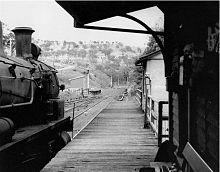Ardglen Tunnel

Ardglen station with a train past summit of the Liverpool Range, 26 October 1954
|
|
| Official name | Ardglen tunnel |
|---|---|
| Other name(s) | Liverpool Range tunnel |
| Operation | |
| Constructed | Mr. J. Wolfe Mr. William Wakeford |
| Opened | August 1877 |
| Technical | |
| Length | 528 yards (483 m) |
| Track gauge | 4 ft 8 1⁄2 in (1,435 mm) |
The Ardglen Tunnel is a summit tunnel on the Main North railway in New South Wales, Australia, between Newcastle and Werris Creek. It crosses under the Liverpool Range near its east end below Nowlands Gap (otherwise known as Murrurundi Gap), the crossing used by the New England Highway.
It is approximately 500 metres long, and is approached on either side by 10-kilometre climbs at the ruling grade of 1 in 40 (2.5%). The tunnel is single tracked, which combined with the steep grades make this section a bottleneck.
Construction of the tunnel was commenced by boring from both ends. The new line from Murrurundi had been finished up to the east of the tunnel to aid in sthe supply of materials, and the two bores had met with the tunnel navigable by foot. By June 1876 the tunnel was enlarged and brick lined with track laid. The contractors engine made it through the tunnel by July 1876. The line to Quirindi was opened in August 1877.
The stations on either side of Ardglen Tunnel from the south are:
Because the Ardglen tunnel is at the summit of ruling grades, and because of its narrow profile, the tunnel had fume problems during steam days. Larger locomotives such as the 60-class Garratt were either prohibited or limited in load. Fortunately heavy trains tended to go though the tunnel (towards Sydney and Newcastle) in the downhill direction.
To cope with considerably increased coal traffic from north of the tunnel from 2010 and beyond, various deviations are proposed. These deviations can either keep the existing summit tunnel, or bore a much longer tunnel at a 200m lower elevation. The deviations that keep the existing tunnel increase the length of the line so as to ease the gradient to 1 in 80 which is the ruling gradient on the rest of the line to the port. The existing line would be retained for empty trains going the other way, so forming double track.
...
Wikipedia
